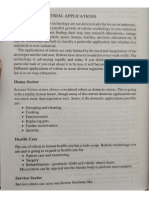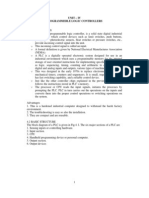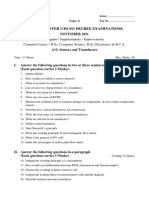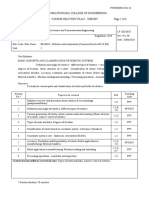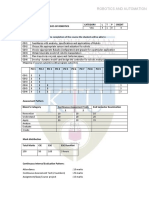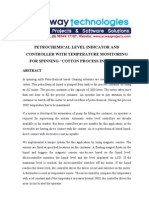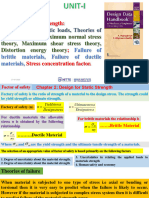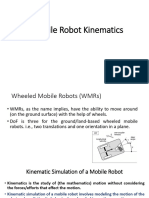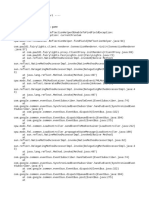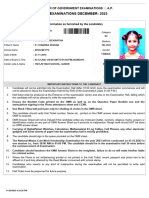Wheeled
Mobile Robots
Vincent Linish Dsouza
NMAMIT
Introduction to
mobile robots and
mobile manipulators
• Effector
• An effector is any robot or robotic device that has an effect on the
environment.
• Effectors are essential for robots to carry out their tasks, as they enable
the robot to manipulate objects or perform various actions that have The role of the
an impact on the environment. controller is to
• Locomotion get the
effectors to
• If the effect on the environment causes motion of the effector itself. produce the
e.g., Mobile robot desired effect
• Manipulation: on the
environment,
• If the effect on the environment causes motion of the objects
based on the
around. robot's task.
e.g., Robotic manipulator
Mobile Manipulators
• Mobile manipulators are a combination of
mobile robots and robotic manipulators,
such as robotic arms or grippers.
• This combination provides the capability of
both locomotion and manipulation,
enabling the robot to move around and
interact with its environment.
• Mobile manipulators are especially useful
in scenarios where both mobility and
dexterity are required, such as in complex
assembly tasks, maintenance work, or
even assisting humans in daily activities.
Mobile Robots
• A mobile robot is an automatic machine that
is capable of locomotion.
• Mobile robots are autonomous or semi-
autonomous machines that can move within
their environment and perform tasks without
direct human intervention.
• They are designed to navigate and adapt to
changing environments and are equipped
with various sensors, actuators, and control
systems to complete their missions.
• Mobile robots can be found in a variety of
applications, including manufacturing,
logistics, search and rescue, agriculture, and
more
• Mobile robotics cover robots that roll, walk,
fly or swim.
Mobile Robots
• They may travel on the ground, on
the surface of bodies of water,
underwater, and in the air.
• This is in contrast with fixed - base
robotic manipulators that are
typically programmed to perform
repetitive tasks with perhaps limited
use of sensors, whereas mobile
robots are typically less structured in
their operation and likely to use more
sensors.
Mobile robots need to answer
three fundamental
questions to operate effectively
• Mobile robots need to address three fundamental questions to
operate effectively in their environments and perform tasks
autonomously or semi-autonomously.
• Where am I?
• Where am I going?
• How do I get there?
• To answer these questions the robot must first:
• Make measurements and Model the environment (given or
autonomously built)
• Localize itself
• Plan a path to its goal and control its motion
• This will deal with Locomotion and Navigation (Perception,
Localization, Planning and motion generation)
Components of Robotic system consists of
• Body
a mobile robot • Brain
• A mobile robot requires several components that work together to enable the robot to move, sense its environment,
and perform tasks autonomously or semi-autonomously.
• A mobile robot is a combination of various physical (hardware) and computational (software or planning) components.
• In terms of hardware components, a mobile robot can be considered as a collection of subsystems for:
• Locomotion - how the robot moves through its environment?
• The choice of locomotion depends on the specific application and the type of terrain the robot will operate in
• Sensing and perception- how the robot measures properties of itself and its environment?
• Sensors and perception systems enable the robot to gather information about its surroundings, detect obstacles, and
interpret the environment.
• Control and navigation - how the robot executes its planned actions?
• The control and navigation system processes the information from the sensing and perception system to plan and
execute motion.
• Communication - how the robot communicates with an outside operator?
• Power system- Mobile robots require a power source to operate their various components, including motors,
sensors, and onboard computers.
Classification of Mobile Robots
In terms of the environment, they move across they
can be classified into some principal groups:
• Ground mobile systems
• mobile vehicles with wheels or caterpillars,
legged robots (humanoids or animal
mimicking),
• Aerial mobile systems
• mobile systems that fly in a certain aerial
space (airplanes, helicopters, drones, rockets,
animal-mimicking flying systems or orbit the
Earth or some other celestial body (satellites).
• Water and underwater mobile systems
• ships, boats, submarines, autonomous
underwater vehicles, etc
• Miscellaneous (space-based, ice-based and hybrid
environments)
Applications
of mobile
robots
Locomotion
• Locomotion is the process of causing a
mobile robot to move.
• In order to produce motion,
forces/torques must be applied to the
mobile base
• A mobile robot needs locomotion
mechanisms that enable it to move
unbounded throughout its environment.
• Large variety of possible ways to move,
and so the selection of a robot's
approach to locomotion is an important
aspect of mobile robot design.
• The mobile robots that can walk, jump,
run, slide, skate, swim, fly, and roll.
• land-based mobile robots (simply, Mobile robots) generally
uses either wheeled mechanisms, or a small number of
articulated legs.
• Legged locomotion requires higher degrees of freedom and
therefore greater mechanical complexity than wheeled
locomotion.
• Wheels, in addition to being simple, are extremely well suited
to at ground.
• On flat surfaces wheeled locomotion is one to two orders of
magnitude more efficient than legged locomotion.
Locomotion mechanisms used in biological
(nature) systems (land based)
Key issues for locomotion
• Stability
• number of contact points
• centre of gravity
• static/dynamic stabilization
• inclination of terrain
• Characteristics of contact
• contact point or contact area
• angle of contact
• friction
• Type of environment
• structure
• medium (soft or hard ground)
• Stability: Robots need to maintain balance to prevent falling or tipping over. Stability is influenced by the
robot's center of gravity and its base of support.
• Number of contact points: The number and type of contact points (wheels, legs, tracks, etc.) affect a robot's
mobility, stability, and ability to navigate different terrains.
• Center of Gravity: The position of the center of gravity affects a robot's stability. Ideally, it should be as low as
possible and within the base of support to maximize stability.
• Static/Dynamic Stabilization: Static stabilization involves maintaining balance while stationary. Dynamic
stabilization involves maintaining balance while in motion. Both types of stabilization are crucial for mobile
robots.
• Inclination of terrain: The slope of the terrain influences the robot's ability to maintain balance and traction.
Robots may need specialized mechanisms to navigate steep inclines or declines.
• Characteristics of Contact: The nature of the robot's interaction with the ground is critical. For instance, the
type of contact (point or area), the angle of contact, and the friction between the robot and the ground all
influence the robot's locomotion.
• Friction: Adequate friction between the robot's contact points and the ground is necessary for locomotion.
Too much friction can lead to wear and tear, while too little can lead to slippage.
• Type of Environment: The structure of the environment (e.g., open, cluttered) and the medium (e.g., soft
ground, hard ground, water, air) can greatly affect a robot's locomotion. Robots need to be designed with
their intended environment in mind.
• Structure: The structure of the robot affects its locomotion. For example, a robot with a long wheelbase will
be more stable than a robot with a short wheelbase.
• Medium (soft or hard ground):The medium that the robot is moving on affects its locomotion. For example, a
robot will move differently on soft ground than it will on hard ground
Mobile Robotics is very interdisciplinary
because there is a diverse set of
challenges in robotics research.
• Locomotion involves mechanism and
kinematics, dynamics and control
• Perception involves signal analysis, computer
vision and sensor technology
• Navigation involves computer algorithms,
information theory, probability theory, and
state estimation.
Four Pillars of
Robotics
Common approaches of land-based mobile robots Locomotion
• Wheeled
• Legged
• Tracked (slip/skid)
• Hybrid
Land-based mobile robots
• The railway is ideally engineered for wheeled
locomotion because rolling friction is minimized
on a hard and at steel surface.
• But as the surface becomes soft, wheeled
locomotion accumulates inefficiencies due to
rolling friction whereas legged locomotion
suffers much less because it consists only of
point contacts with the ground.
Land-based mobile robots
• The efficiency of wheeled locomotion depends greatly on environmental
qualities, particularly the flatness and hardness of the ground.
• The efficiency of legged locomotion depends on the leg mass and body mass,
both of which the robot must support at various points in a legged gait.
Land-based mobile robots
• Land-based wheeled robots are the most popular mobile robots among
beginners as they usually require the least investment while providing
significant exposure to robotics.
The most complex type of robots is the autonomous humanoid (resembling a human), as
it requires many degrees of freedom, synchronizing many motors and many sensors.
• Stability is not typically an issue in wheeled
robot designs because all wheels are on the Wheeled Mobile Robots
ground at the same time.
• Three wheels are sufficient to guarantee
stable balance and more than three wheels
require a suspension system.
• Nature favors legged locomotion to operate
on rough and unstructured terrain.
• The human working environment
frequently consists of engineered, smooth
surfaces, both indoors and outdoors.
• Therefore, all industrial applications of
mobile robotics utilize some form of
wheeled locomotion.
• Recently, for performing more natural
outdoor environment based tasks, usage of
hybrid locomotion mechanisms are
preferred.







